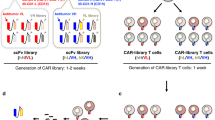Abstract
Antitumor immune responses are mediated primarily by T cells1. Downregulation of the major histocompatiblity complex (MHC) and the molecules that costimulate the immune response is associated with defective signaling by tumor cells for T-cell activation2–14. In vitro treatment with a combination of cytokines significantly increased the expression of MHC class I and adhesion molecules on tumor cell surfaces. When tumor cells were first incubated with a bispecific monoclonal antibody that binds antigen on tumor cells to CD28 on T cells, the modified tumor cells become immunogenic and are able to stimulate naive T cells, generating tumor-specific cytotoxic T cells in vitro. Immunization with the modified tumor cells elicits an immune response mediated by CD8+ T cells. This response protected against a challenge with parental tumor cells and cured established tumors. The approach was effective in both low immunogenic and nonimmunogenic tumor model systems. Modification of tumor cells with this two-step procedure may provide a strategy for development of tumor vaccines that is effective for cancer immunotherapy.
This is a preview of subscription content, access via your institution
Access options
Subscribe to this journal
Receive 12 print issues and online access
$209.00 per year
only $17.42 per issue
Buy this article
- Purchase on Springer Link
- Instant access to full article PDF
Prices may be subject to local taxes which are calculated during checkout
Similar content being viewed by others
References
Restifo, N.P. & Wunderlich, J.R. Biology of Cellular Immune Responses: Biological Therapy of Cancer. 2nd edn. (eds. DeVita, V.T., Jr., Hellman, S. & Rosenberg, S.A.) Chapt. 1, 3–37 (Lippincott, Philadelphia, (1995).
Chen, L. et al. Costimulation of antitumor immunity by the B7 counterreceptor for the T lymphocyte molecule CD28 and CTLA-4. Cell 71, 1093–1102 (1992).
June, C.H., Bluestone, J.A., Nadler, L.M. & Thompson, C.B. The B7 and CD28 receptor families. Immunol. Today 15, 321–331 (1994).
Townsend, S.E. & Allison, J.P. Tumor rejection after direct costimulation of CD8* T cells by B7 transfected melanoma cells. Science 259, 368–370 (1993).
Allison, J.P. CD28-B7 interactions in T cell activation. Curr. Opin. Immunol. 6, 414–419 (1994).
Harding, F.A., McAithur, J.G., Gross, J.A., Raulet, D.H. & Allison, J.P. CD28-mediated signaling co-stimulates murine T cells and prevent induction of anergy in T cell clones. Nature 356, 607–609 (1992).
Yang, G., Hellström, K.E., Hellström, I. & Chen, L. Antitumor immunity elicited by tumor cells transfected with B7-2, a second ligand for CD28/CTLA-4 costimulatory molecules. J. Immunol. 154, 2794–2800 (1995).
Walunas, T.L. et al. CTLA-4 can function as a negative regulator of T cell activation. Immunity 1, 405–413 (1994).
Krummel, M.F. & Allison, J.P. CTLA-4 engagement inhibits IL-2 accumulation and cell cycle progression upon activation of resting T cells. J. Exp. Med. 183, 2533–2540 (1996).
Walunas, T.L., Bakker, C.Y. & Bluestone, J.A. CTLA-4 ligation blocks CD28-dependent T cell activation. J. Exp. Med. 183, 2541–2550 (1996).
Tivol, E.A. et al. Loss of CTLA-4 leads to massive lymphoproliferation and fatal multiorgan tissue destruction, revealing a critical negative regulatory role of CTLA-4. Immunity 3, 541–547 (1995).
Leach, D.R., Krummel, M.K. & Allison, J.P. Enhancement of antitumor immunity by CTLA-4 blockade. Science 271, 1734–1736 (1996).
Guo, Y.J. et al. Effective vaccine generated by fusion of hepatoma cells with B cells. Science 263, 518–520 (1994).
Grabbe, S., Beissert, S., Schwarz, T. & Granstein, R.D. Dendritic cells as initiators of tumor immune responses: A possible strategy for tumor immunotherapy. Immunol. Today 16, 117–121 (1995).
Darlington, G.J., Bernhard, H.P., Miller, R.A. & Ruddle, F.H. Expression of liver phenotypes in cultured mouse hepatoma cells. J. Natl. Cancer Inst. 64, 809– (1980).
Renner, C. et al. Cure of xenografted human tumors by bispecific monoclonal antibodies and human tumor cells. Science 264, 833–835 (1994).
MacLean, J.A. et al. Anti-CD3:anti-IL-2 receptor bispecific monoclonal antibody targeting of activated T cells in vitro. J. Immunol. 150, 1619–1628 (1993).
Huang, A.Y. et al. Role of bone marrow-derived cells in presenting MHC class I restricted tumor antigen. Science 264, 961–965 (1994).
Hsu, F.J. et al. Vaccination of patients with B-cell lymphoma using autologous antigen-pulsed dendritic cells. Nature Med. 2, 52–58 (1996).
Takahashi, H., Nakada, T. & Puisieux, I. Inhibition of human colon cancer growth by antibody-directed human LAK cells in scid mice. Science 259, 1460–1463 (1993).
Author information
Authors and Affiliations
Rights and permissions
About this article
Cite this article
Guo, YJ., Che, XY., Shen, F. et al. Effective tumor vaccines generated by in vitro modification of tumor cells with cytokines and bispecific monoclonal antibodies. Nat Med 3, 451–455 (1997). https://doi.org/10.1038/nm0497-451
Received:
Accepted:
Issue Date:
DOI: https://doi.org/10.1038/nm0497-451
This article is cited by
-
Agonist redirected checkpoint, PD1-Fc-OX40L, for cancer immunotherapy
Journal for ImmunoTherapy of Cancer (2018)
-
Achievements in cancer research supported by National Natural Science Foundation of China
Chinese Science Bulletin (2013)
-
Eradication of hepatoma and colon cancer in mice with Flt3L gene therapy in combination with 5-FU
Cancer Immunology, Immunotherapy (2007)
-
Treatment of hepatocellular carcinoma with adenoviral vector-mediated Flt3 ligand gene therapy
Cancer Gene Therapy (2005)
-
Experimental vaccine strategies for cancer immunotherapy
Journal of Biomedical Science (1998)



